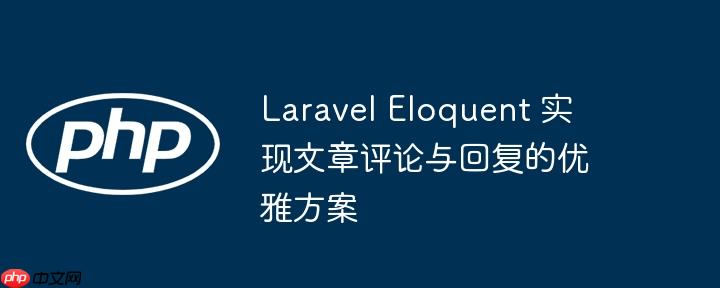
实现评论回复功能的核心在于数据库表的结构设计。我们需要一个自引用的字段来标识评论与其回复之间的父子关系。以下是 article_comments 表的推荐结构:
Schema::create('article_comments', function (Blueprint $table) {
$table->bigIncrements('id');
$table->unsignedBigInteger('article_id'); // 所属文章ID
$table->foreign('article_id')
->references('id')->on('articles')->onDelete('cascade'); // 外键约束,文章删除时评论一并删除
$table->string('name'); // 评论者名称
$table->string('email'); // 评论者邮箱
$table->text('text'); // 评论内容
$table->timestamp('date')->nullable(); // 评论日期,使用 timestamp 类型更灵活
$table->unsignedBigInteger('comment_id')->nullable(); // 自引用字段,指向父评论ID
$table->foreign('comment_id')
->references('id')->on('article_comments')->onDelete('set null'); // 外键约束,父评论删除时子评论的comment_id设为null
$table->timestamps(); // created_at 和 updated_at
});关键点说明:
在 Laravel 中,Eloquent ORM 提供了强大而简洁的方式来定义模型之间的关系。为了实现评论和回复的层级结构,我们需要在 ArticleComment 模型中定义一个自引用关系,并在 Article 模型中定义其与评论的关系。
1. ArticleComment 模型中的自引用关系
在 app/Models/ArticleComment.php 文件中,添加 answers 关系,表示一个评论可以有多个回复。
// app/Models/ArticleComment.php
<?php
namespace App\Models;
use Illuminate\Database\Eloquent\Model;
use Illuminate\Database\Eloquent\Relations\HasMany;
class ArticleComment extends Model
{
protected $fillable = [
'article_id', 'name', 'email', 'text', 'date', 'comment_id'
];
/**
* 获取此评论的所有回复。
*/
public function answers(): HasMany
{
return $this->hasMany(ArticleComment::class, 'comment_id', 'id');
}
/**
* 获取此回复所属的父评论。
*/
public function parentComment(): BelongsTo
{
return $this->belongsTo(ArticleComment::class, 'comment_id', 'id');
}
/**
* 获取此评论所属的文章。
*/
public function article(): BelongsTo
{
return $this->belongsTo(Article::class);
}
}2. Article 模型中的评论关系
在 app/Models/Article.php 文件中,定义文章与其评论的关系。
// app/Models/Article.php
<?php
namespace App\Models;
use Illuminate\Database\Eloquent\Model;
use Illuminate\Database\Eloquent\Relations\HasMany;
class Article extends Model
{
protected $fillable = [
'title', 'content', /* 其他字段 */
];
/**
* 获取此文章的所有顶级评论。
*/
public function comments(): HasMany
{
return $this->hasMany(ArticleComment::class, 'article_id', 'id')
->whereNull('comment_id'); // 仅获取顶级评论
}
}为了在页面上显示文章、其所有顶级评论以及这些评论的所有回复,最有效的方法是使用 Eloquent 的预加载(Eager Loading)功能。这可以避免 N+1 查询问题,显著提高性能。
方法一:一次性加载文章、评论及回复 (推荐)
这种方法通过一次数据库查询获取所有相关数据,特别适合在同一页面显示文章、其所有顶级评论及其回复的场景。
use App\Models\Article;
// 假设要获取 ID 为 1 的文章及其评论
$articleId = 1;
$articleWithComments = Article::where('id', $articleId)
->with(['comments' => function($query) {
$query->whereNull('comment_id') // 筛选出顶级评论
->with('answers'); // 预加载顶级评论的所有回复
}])
->first(); // 使用 first() 获取单个文章模型
// 如果需要转换为数组查看结构
// $output = $articleWithComments->toArray();查询结果示例(简化结构):
{
"id": 1,
"title": "文章标题",
"content": "文章内容",
"comments": [
{
"id": 1,
"article_id": 1,
"name": "评论者A",
"text": "这是一条顶级评论。",
"comment_id": null,
"answers": [ // 评论1的回复
{
"id": 5,
"article_id": 1,
"name": "回复者X",
"text": "这是对评论1的回复1。",
"comment_id": 1
},
{
"id": 6,
"article_id": 1,
"name": "回复者Y",
"text": "这是对评论1的回复2。",
"comment_id": 1
}
]
},
{
"id": 2,
"article_id": 1,
"name": "评论者B",
"text": "这是另一条顶级评论。",
"comment_id": null,
"answers": [] // 评论2没有回复
}
]
}优势: 这种方法仅执行少量查询(通常是文章表一次,评论表一次),避免了在循环中反复查询数据库,极大地提高了页面加载效率。
方法二:按需查询特定评论的回复
在某些情况下,你可能需要独立地查询某个特定评论的回复,或者某个评论及其所有回复。
仅获取某个评论的所有回复:
use App\Models\ArticleComment;
$parentCommentId = 1; // 假设要获取 ID 为 1 的评论的回复
$replies = ArticleComment::where('comment_id', $parentCommentId)->get();获取某个评论及其所有回复:
use App\Models\ArticleComment;
$commentId = 1; // 假设要获取 ID 为 1 的评论及其回复
$commentWithReplies = ArticleComment::where('id', $commentId)
->with('answers')
->first();获取到数据后,在 Blade 模板中渲染评论和回复是直观的。我们可以利用数据的嵌套结构来构建评论列表。
<!-- article_show.blade.php -->
<div class="comment-list">
@if($articleWithComments && $articleWithComments->comments->isNotEmpty())
@foreach($articleWithComments->comments as $comment)
<div class="comment-list__item">
<div class="item-card">
<div class="item-card__header">
<div class="item-card__title">
<div class="label">
{{ $comment->name }}
</div>
<div class="data">
{{ date('d F Y', strtotime($comment->date)) }}
</div>
</div>
</div>
<div class="item-card__content">
{{ $comment->text }}
</div>
</div>
{{-- 渲染此评论的回复 --}}
@if($comment->answers->isNotEmpty())
<div class="comment-sub-list">
@foreach($comment->answers as $reply)
<div class="comment-sub-list__item">
<div class="item-card">
<div class="item-card__header">
<div class="item-card__title">
<div class="label">
{{ $reply->name }}
</div>
<div class="data">
{{ date('d F Y', strtotime($reply->date)) }}
</div>
</div>
</div>
<div class="item-card__content">
{{ $reply->text }}
</div>
</div>
</div>
@endforeach
</div>
@endif
</div>
@endforeach
@else
<p>暂无评论。</p>
@endif
</div>渲染逻辑说明:
通过精心设计的数据库表结构、Eloquent 模型关系以及高效的数据查询策略,我们可以在 Laravel 中优雅地实现文章评论及其回复功能。采用预加载和结构化的视图渲染方式,不仅能够确保系统性能,还能提供良好的代码可维护性。遵循这些实践,可以构建一个功能完善且用户体验出色的评论系统。
以上就是Laravel Eloquent 实现文章评论与回复的优雅方案的详细内容,更多请关注php中文网其它相关文章!

每个人都需要一台速度更快、更稳定的 PC。随着时间的推移,垃圾文件、旧注册表数据和不必要的后台进程会占用资源并降低性能。幸运的是,许多工具可以让 Windows 保持平稳运行。

Copyright 2014-2025 https://www.php.cn/ All Rights Reserved | php.cn | 湘ICP备2023035733号